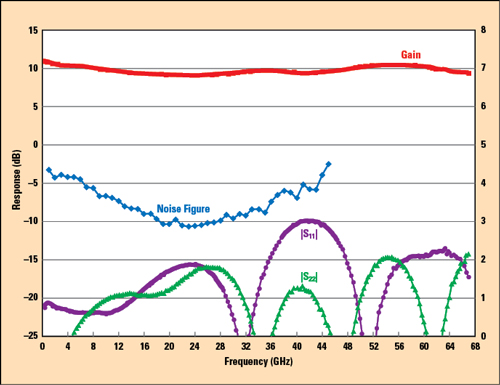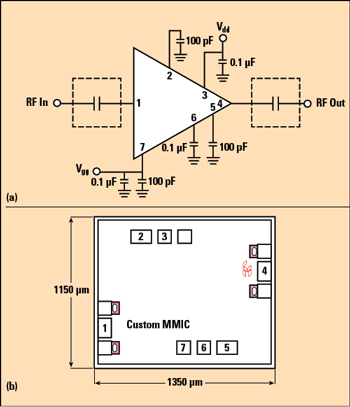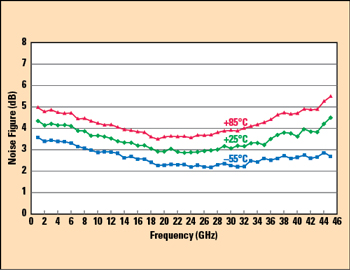Broadband system designers are constantly pushing the envelope to get better performance, whether the design is a state-of-the-art microwave instrument or a robust electronic warfare (EW) system. The demand for consistently better performance across the required band makes the design task difficult, and the continued expansion of bandwidth only exacerbates the challenge. Not long ago, EW systems focused on DC to 20 GHz. Now, DC to 50 GHz - even higher - are becoming common. Instrumentation designers are challenged to enable the EW designers to test their designs, and the growth of mmWave 5G and 802.11ad add more markets challenging instrument capabilities.
Many microwave ICs have significant variation in performance over frequency, which is compounded by the operating voltage and temperature ranges. Variations in noise figure, gain, output power and linearity are all areas of focus for system designers, with the variation in gain over frequency often the most challenging aspect of the design. The falloff in gain requires additional high frequency gain stages, with equalizers to maintain flatness. MMIC innovations have emerged to support these broadband requirements. Custom MMIC’s GaAs amplifiers with attractive characteristics, such as flat or positive gain slope over a 30 GHz bandwidth, are examples. Now, the new > 50 GHz systems have pushed Custom MMIC’s designers to further innovation, where achieving flat gain is the new requirement set by users.
To address this evolution, at the 2019 International Microwave Symposium, Custom MMIC introduced the CMD304 DC to 67 GHz distributed driver amplifier to support the design of high performance, broadband systems. The amplifier features 9.5 dB gain and a 3 dB noise figure, with +11 dBm output power at 1 dB compression at 30 GHz. The GaAs MMIC is biased with a single positive 3 V supply, drawing a mere 40 mA. Importantly, the CMD304 has very flat gain characteristic across the full band (see Figure 1), which eliminates the need for additional gain and equalization stages.

Figure 1 Performance of the CMD304 at T = 25°C, with Vdd = 3 V and Idd = 40 mA.

Figure 2 Fig. 2 Using the CMD304 requires only a few external capacitors, keeping the amplifier’s footprint small (a). Die layout (b).

Figure 3 CMD304 noise figure vs. temperature. Vdd = 3 V.
The single supply and simple layout of the CMD304 enables easy and cost-effective implementation in a system (see Figure 2). The RF input and output are DC coupled, and the MMIC’s performance is optimized down to DC. The CMD304 can be biased through an external bias tee at pin 4 or using the internal bias network at pin 3, which provides bias through an on-chip 50 Ω drain termination resistor. Using the internal bias network, as shown in Figure 2, provides the broadest performance, yet requires a 2 V higher bias voltage. Input and output coupling capacitors and bypass capacitors are the only external components used with the MMIC. The die size is 1.35 mm x 1.15 mm, yielding a compact footprint.
With its low noise figure, the CMD304 can be used at the receiver front-end for EW systems and test and measurement instruments. The room temperature noise figure is less than 5 dB from low frequency to at least 50 GHz (see Figure 3). The noise figure above 50 GHz is being characterized, with the noise figure at 67 GHz expected to be under 7 dB. The noise figure over temperature falls within approximately ±1 dB (see Figure 3). Broadband designs that do not require the full 67 GHz bandwidth of the CMD304 will benefit from the MMIC’s low noise figure up to 50 GHz - which is better than the noise figure of a 50 GHz distributed amplifier. This is because the noise figure of a distributed amplifier increases well below the high frequency cutoff, even though the gain and return losses remain flat. The CMD304 can also be used as a pre-driver at the output of an instrumentation signal source or in the chain of an EW jammer. The 1 dB compression point of +11 dBm is sufficient to drive the first stage of a power amplifier at these frequencies. This broadband amplifier can serve as a driver between the local oscillator and an up- or down-converting mixer.
The microwave industry remains robust. New systems and applications require improved capability to serve government, business and consumer users, challenging MMIC suppliers to continue meeting new requirements. Custom MMIC would not want it any other way.
Custom MMIC
Chelmsford, Mass.
www.custommmic.com
